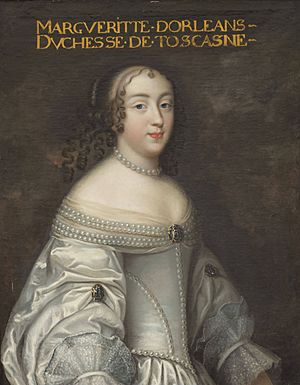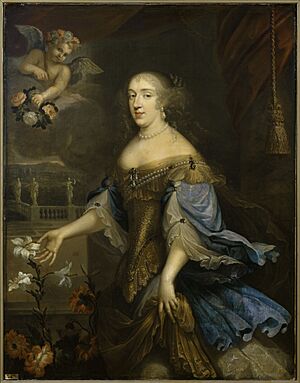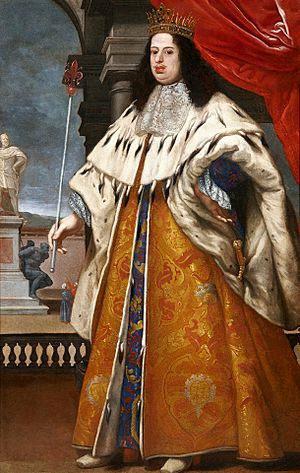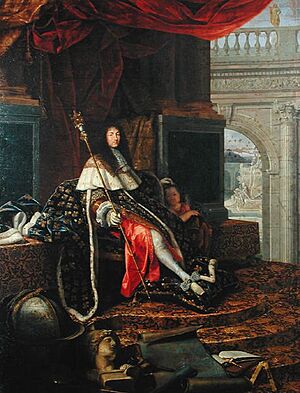Marguerite Louise d'Orléans facts for kids
Quick facts for kids Marguerite Louise d'Orléans |
|||||
|---|---|---|---|---|---|
 |
|||||
| Grand Duchess consort of Tuscany | |||||
| Tenure | 23 May 1670 – 17 September 1721 | ||||
| Born | 28 July 1645 Château de Blois, Blois, France |
||||
| Died | 17 September 1721 (aged 76) 15 Place des Vosges, Paris, France |
||||
| Burial | Picpus Cemetery, Paris, France | ||||
| Spouse | Cosimo III de' Medici | ||||
| Issue Detail |
Ferdinando, Grand Prince of Tuscany Anna Maria Luisa, Electress Palatine Gian Gastone, Grand Duke of Tuscany |
||||
|
|||||
| House | Bourbon | ||||
| Father | Gaston, Duke of Orléans | ||||
| Mother | Marguerite of Lorraine | ||||
| Religion | Roman Catholicism | ||||
Marguerite Louise d'Orléans (born July 28, 1645 – died September 17, 1721) was a French princess. She became the Grand Duchess of Tuscany when she married Grand Duke Cosimo III de' Medici.
Marguerite Louise was known for being independent and strong-willed from a young age. Her relationship with her husband and his family was difficult and often unhappy. She often asked Louis XIV for help to solve their problems. Despite these issues, they had three children: Ferdinando, Anna Maria Luisa, and Gian Gastone.
In June 1675, Marguerite Louise and her husband separated. She moved to a convent outside Paris with money for her living. In France, she didn't always follow the rules for women of her high position. She caused problems for both the Tuscan and French royal families.
Later in life, she became more traditional. She started doing good deeds and even helped improve the convent where she lived. As she got older, she faced health problems. She also felt great sadness after losing her eldest son, Ferdinando, whom she truly loved. After inheriting money, she became financially independent. She bought a house in Paris, where she spent her last years giving to charity and writing polite letters.
Contents
Her Story
Early Life: 1645–1661

Marguerite Louise was born on July 28, 1645, at the Château de Blois. She was the oldest child of Gaston of France, Duke of Orléans, and his second wife, Marguerite of Lorraine. She had four younger siblings from her father's second marriage. Her sisters included Élisabeth Marguerite, who later became the Duchess of Guise.
Marguerite Louise received a basic education at her father's court in Blois. Her father had moved there after a failed rebellion against his nephew, Louis XIV of France, called the Fronde. Marguerite Louise was very close to her half-sister, Anne Marie Louise, Duchess of Montpensier, also known as La Grande Mademoiselle. Her half-sister took her to plays and royal balls. Marguerite Louise returned her sister's affection. She visited Anne Marie Louise's home every day and asked for her advice on court matters.
Marguerite Louise believed that her mother's advisor had given bad advice. This advice ruined plans for her to marry Charles Emmanuel II, Duke of Savoy. In the end, her younger sister Françoise Madeleine d'Orléans married Charles Emmanuel in 1663. Because of this, when Cosimo de' Medici, Grand Prince of Tuscany, proposed marriage in 1658, Marguerite Louise asked her half-sister to help make it happen.
At first, Marguerite Louise was very happy about the idea of getting married. But her excitement turned to sadness when her half-sister changed her mind. In response, Marguerite Louise started acting in unusual ways. She shocked the court by going out alone with her cousin Prince Charles of Lorraine. This was a serious offense at the time, and Charles soon became her lover. Her marriage by proxy on April 19, 1661, did not change her behavior. This annoyed King Louis XIV's ministers. On the day she was supposed to meet diplomats to receive congratulations for her wedding, she tried to go hunting instead. The Duchess of Montpensier had to stop her.
Life in Tuscany: 1661–1670
Grand Princess of Tuscany

Mattias de' Medici, who was the brother of the current Grand Duke and her future husband's uncle, brought Marguerite Louise to Tuscany. They traveled with a fleet of nine ships. Against all proper rules, Charles of Lorraine said goodbye to her in Marseille. The group arrived in Tuscany on June 12. Marguerite Louise got off the ship in Livorno. With much celebration, she officially entered Florence on June 20. Their wedding parties were the most grand Florence had ever seen. They included a parade of over three hundred carriages. As a wedding gift, Grand Duke Ferdinando, her husband's father, gave her a pearl as big as a small pigeon's egg.
Marguerite Louise and Cosimo greeted each other with little interest. According to Sophia, Electress of Hanover, they only slept together once a week. Two days after their marriage, Marguerite Louise demanded the Tuscan crown jewels from Cosimo. He replied that he did not have the power to give them to her. The jewels she did get from Cosimo, she tried to secretly take out of Tuscany. But the Grand Duke stopped her. After this event, Marguerite Louise's lack of interest turned into hatred. This was made worse by her continued love for Charles of Lorraine, whom she had to leave in Marseilles. Once, she even threatened to break a bottle over Cosimo's head if he didn't leave her room.
However, her hatred for Cosimo did not stop them from having children, which was their duty. They had Grand Prince Ferdinando in 1663, Anna Maria Luisa in 1667, and Gian Gastone in 1671.
Marguerite Louise's unusual behavior led to bad relationships with the family. She argued with the Grand Duchess Vittoria over who was more important. She also argued with Grand Duke Ferdinando about her spending. Her spending habits not only caused conflict with the Grand Duke but also made her unpopular with the people of Florence. This was made worse by her free-spirited actions, such as having two male servants visit her room at all hours.
Appeals to Louis XIV
After Charles of Lorraine briefly visited Florence, where the Grand Ducal family entertained him, Marguerite Louise's letters to Charles caused problems. The Grand Duke and Cosimo started spying on her. In response, she asked Louis XIV to step in, but it didn't work. Then, both Marguerite Louise and the Grand Duke sent requests to Louis XIV after her French staff were fired. Marguerite Louise complained about being treated badly. The Grand Duke asked for help controlling Marguerite Louise's behavior.
To calm both the Grand Duke and Marguerite Louise, Louis XIV sent the Comte de Saint Mesme. During their talks, it became clear that Marguerite Louise wanted to return to France. Mesme agreed with this, as did many at the French court. So, he finished his visit without finding a solution to the family's problems. This angered both Ferdinando and Louis XIV. Now, Marguerite Louise began to force the issue. She humiliated Cosimo whenever she could. For example, she insisted on hiring only French cooks, claiming the Medici family wanted to poison her. She also called Cosimo "a poor groom" in front of the Papal nuncio.
After several more French attempts to make peace failed, Marguerite Louise left her apartment in Palazzo Pitti in September 1664. She refused to return. As a result, Cosimo moved her to Villa di Lappeggi. There, forty soldiers watched her, and six courtiers, chosen by Cosimo, had to follow her everywhere. This was because they feared she would run away to France. The next year, she changed her approach and made peace with the Grand Ducal family. However, that peace ended after the birth of Anna Maria Luisa in 1667.
Grand Duchess of Tuscany: 1670–1721

In May 1670, Grand Duke Ferdinando II died. Marguerite Louise then became Grand Duchess of Tuscany. An old tradition was brought back when Cosimo III became ruler. This tradition allowed the reigning Grand Duke's mother to join the Consulta, or Privy Council. Vittoria della Rovere, Cosimo III's mother, disliked Marguerite Louise for how she treated Cosimo and herself. So, Vittoria made sure Marguerite Louise was not allowed to join the Consulta.
Because she was kept out of politics, Marguerite Louise had nothing to do but oversee the education of her son, Grand Prince Ferdinando. The Grand Duchess was very angry about being excluded. She argued with Vittoria over who was more important and demanded to join the Consulta. Cosimo III sided with his mother. It seems another short peace happened in the summer of 1670. A sign of this was the birth of their last child, Gian Gastone, on May 24, 1671. Gian Gastone was born on the first anniversary of his grandfather Ferdinando II's death. This gave a reason for the child to be named after his other grandfather, Gaston, Duke of Orléans, who had died in 1660. Gian Gastone would later become the last Medici Grand Duke of Tuscany.
Return to France
In early 1672, Marguerite Louise wrote to Louis XIV. She begged him for medical help for what she called breast cancer. To treat her, Louis XIV sent Alliot le Vieux, the personal doctor who had cared for his mother Anne of Austria, who had died from the same illness. Alliot, unlike Mesme, did not fully agree with Marguerite Louise's wish to be sent to France because of her illness. He said the tumor was "not at all harmful," though he did suggest thermal waters.
Frustrated that her plan failed, Marguerite Louise started flirting with a cook in her household to upset Cosimo. She would tickle him and have pillow fights.
To try and bring peace back to the family, Cosimo III sent for Madame du Deffand. She had been Marguerite Louise's childhood governess and had sided with the Grand Duke before. However, because of several deaths in the Orléans family, the governess arrived late, in December 1672. By then, Marguerite Louise was very sad. She asked to visit Villa Poggio a Caiano, a Medici villa, supposedly to worship at a nearby shrine. Once there, she refused to return. This led to a two-year disagreement between her and the Grand Duke. He would not agree to her return to France, even though she begged for it in her goodbye letter to him.
Madame du Deffand's mission failed. Louis XIV made one last attempt to make the Grand Ducal couple reconcile, but it was no use. So, all attempts at peace had failed. Cosimo finally gave in to Marguerite Louise. They signed a contract on December 26, 1674. Marguerite Louise was allowed to leave for France with a payment of 80,000 livres. But she had to stay at the Abbey of Saint Peter at Montmartre. She also had to give up her rights as a Royal Princess of France. The Grand Duchess was overjoyed. She left for France with the furniture and items from Villa Poggio a Caiano. In her own words, she had no intention "of setting forth without her proper wages."
Montmartre

News of Marguerite Louise leaving Livorno on July 12, 1675, was met with "great displeasure" by the people of Florence. The nobles also felt sympathy for her. They believed Cosimo was to blame for driving Marguerite Louise away. At Montmartre, Marguerite Louise at first supported charity work and acted with "an air of piety." But she soon went back to her unusual ways. She wore heavy makeup and bright yellow wigs. She also started a relationship with the Count of Lovigny, and later with two soldiers. Louis XIV ignored the 1674 contract that banned Marguerite Louise from leaving the convent. He allowed the Grand Duchess to visit court, where she gambled for high amounts of money.
Because of her "shabby" group of followers and short visits, Marguerite Louise gained a reputation as a free spirit among the courtiers at Versailles. Therefore, she was forced to allow "those of insignificant birth" into her social circle. The Tuscan envoy, Gondi, often complained to the French court about Marguerite Louise's behavior, but it didn't help. Eventually, the Abbess of Montmartre, Françoise Renée de Lorraine (1621–1682), was asked by the King about Marguerite Louise's latest relationship with a servant. She replied, "A conspiracy of silence is the only way to deal with the bad behavior and excesses of [Marguerite Louise]." This might explain why Marguerite Louise is not often mentioned in the writings of that time.
Back in Florence, Cosimo III carefully read the reports sent by the Tuscan envoy in France about Marguerite Louise's every move. If he thought something she did was offensive, he wrote to Louis XIV, demanding an explanation. At first, Louis XIV was sympathetic to Cosimo. But he grew tired of Cosimo's endless complaints. He said, "Since Cosimo had agreed to his wife's retirement to France, he had practically given up any right to interfere in her conduct." This made Cosimo III stop worrying about his wife's behavior.
Marguerite Louise learned about Cosimo III's illness from her eldest son, Grand Prince Ferdinando. He supported his mother and wrote letters to her. Certain that her husband would soon die, Marguerite Louise told the French court that "at the first news of her hated husband's death, she would fly to Florence to get rid of all hypocrites and hypocrisy and set up a new government." However, this did not happen. Cosimo III actually lived two years longer than she did.
In 1688, burdened by debts, Marguerite Louise wrote to Cosimo, begging for 20,000 crowns. When Cosimo was not quick to help, she turned to her son, the Grand Prince. She hoped he would help her, but he pretended he couldn't, for fear of upsetting his father. Eventually, Cosimo paid off her debts. Her financial security was ensured when she inherited a large sum of money from a relative in 1696.
While Marguerite Louise's behavior was tolerated by the previous Abbess of Montmartre, the new Abbess, Madame d'Harcourt, often complained about her to the Grand Duke and the King. In return, Marguerite Louise threatened to harm the Abbess with a hatchet and a pistol. She also formed a group against her. Because of this, Cosimo III agreed to Marguerite Louise leaving for a new convent. This was at Saint-Mandé on the eastern edge of Paris. The condition was that she could only go out with King Louis XIV's clear permission. She also had to be accompanied by a chamberlain of his choice. Since she would not agree, her payments were stopped. They were only restarted when Louis XIV forced her to agree.
Saint-Mandé
At Saint-Mandé, the older Marguerite Louise began to live a more calm life. She focused on improving the convent. The mother superior was often absent, while nuns who did not follow the rules were removed. In this way, Marguerite Louise's behavior stopped being a source of disagreement with Florence. Marguerite Louise's health began to get worse in 1712. She had a stroke, which left her with a paralyzed left arm and foaming mouth. She soon recovered, only to have another stroke the next year. The death of her only child with whom she had a good relationship, Grand Prince Ferdinando, contributed to the second stroke. This briefly paralyzed her eyes and made speaking difficult.
The Regent of France, Philippe d'Orléans, allowed Marguerite Louise to buy a house in Paris. It was at 15 Place des Vosges, where she spent her final years. She wrote letters to the Regent's mother, Elizabeth Charlotte of the Palatinate. She also gave generously to charity. Marguerite Louise d'Orléans, Princess of France and Grand Duchess of Tuscany, died in September 1721. She was buried in the Picpus Cemetery, in Paris.
Children
Cosimo III and Marguerite Louise had three children:
- Ferdinando de' Medici, Grand Prince of Tuscany (1663–1713) married Violante Beatrice of Bavaria, but they had no children.
- Anna Maria Luisa de' Medici, Electress Palatine (1667–1743) married Johann Wilhelm, Elector Palatine, but they had no children.
- Gian Gastone de' Medici, Grand Duke of Tuscany (1671–1737) married Anna Maria Franziska of Saxe-Lauenburg, but they had no children.
Images for kids
See also
 In Spanish: Margarita Luisa de Orleáns para niños
In Spanish: Margarita Luisa de Orleáns para niños


